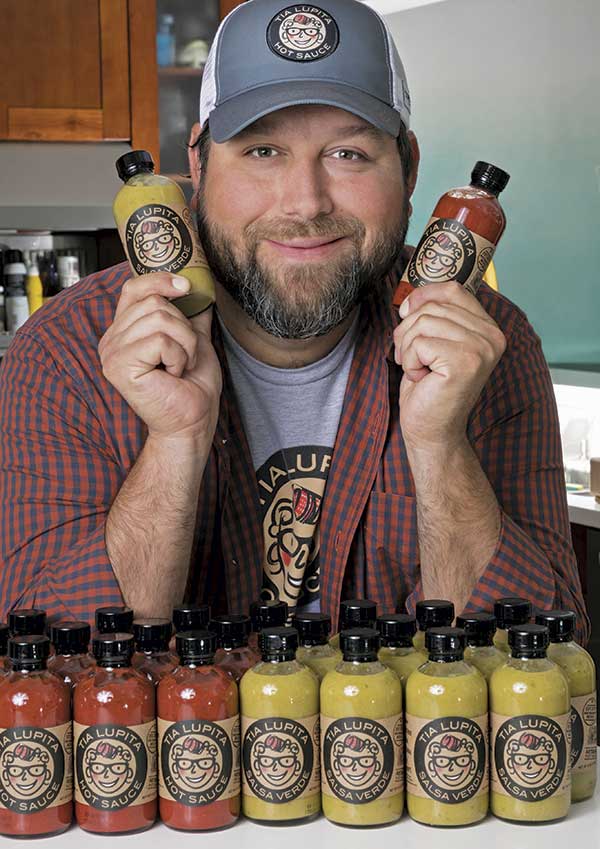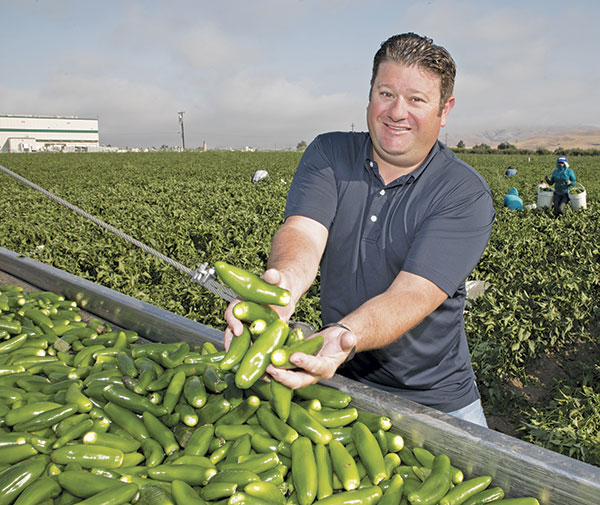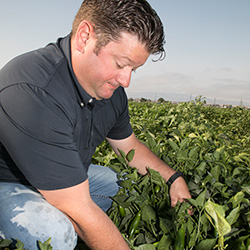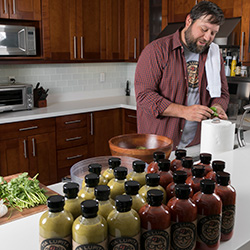Awesome sauce


Hector Saldivar uses jalapeños and other California-grown produce to recreate a generations-old family recipe and create a new one. The labels on his Tia Lupita hot sauce and salsa verde feature his mother's nickname and likeness—hair curler and all. Photo: © 2018 Richard Green
When Hector Saldivar moved from Monterrey, Mexico, to California nearly 15 years ago, he quickly discovered he was missing a taste of home—his mother's hot sauce.
Lupita Maldonado's hot sauce was a favorite in the family's neighborhood when Saldivar was growing up. His friends would invent excuses to come over in hopes of a taste.
"In Mexico, 'tia'—aunt—is a term of endearment," he said. "My friends would show up at our house and call, 'Tia Lupita, I brought some tacos! Do you have any hot sauce?'"
In California, Saldivar scoured retail shops and farmers markets to no avail. Soon, Maldonado began shipping her son bottles of homemade hot sauce. As Saldivar shared the sauce with friends, his supply became in high demand.
With a background in consumer packaged goods at companies such as Nestlé and Diamond Foods, Saldivar saw an opportunity to introduce something unique into the market—if he could convince his mother to share the secret, generations-old family recipe.
"This recipe has been passed down to only one person for generations," Saldivar said. "I asked her, 'Show me how to do it. I want to bottle it and share it everywhere.'"
Maldonado agreed and flew to the Bay Area to pass along not only a recipe, but a family tradition of sharing the knowledge and practices of earlier generations.
After clearing out local farmers markets of red jalapeños, mother and son spent four days in Saldivar's small kitchen recreating a Mexican tradition with California produce. The successful result, bearing his mother's nickname and likeness, was Tia Lupita Hot Sauce.

Saldivar developed the salsa verde recipe in his home kitchen with just a few ingredients: green jalapeños, garlic and cilantro, plus tomatillos, canola oil and salt. Photos: © 2018 Richard Green
A taste of tradition
Saldivar describes the sauce's taste this way: "Immediately, you get sweet and people think it's sugar. But it's the natural sweetness of the peppers. Then a little bit of smoke and earth and then, at the end, you get heat."
He acknowledges the heat challenges some.
"If you ask me, it's just the right amount of heat to get those endorphins going, wake up those taste buds," Saldivar said. "It's meant to complement the food, not mask the flavors."
Cooked in small batches, Tia Lupita Hot Sauce keeps the recipe simple and natural—only red jalapeños, white distilled vinegar, garlic, oregano, cumin, salt and pepper.
The distinct flavors were a hit when Tia Lupita Hot Sauce hit markets in March 2017. As the sauce gained popularity and notice across the nation, Saldivar began thinking green. In Mexico, his mother is best known for her salsa verde, so Saldivar expanded the brand a year later to include Tia Lupita Salsa Verde.
The salsa verde also boasts a simple ingredients list—green jalapeños, tomatillos, garlic, cilantro and salt, all emulsified with canola oil.
"Tia Lupita Salsa Verde tastes very fresh. It has a creamy taste and texture," Saldivar said. "It's very zesty. People get surprised, but it's actually the tomatillos that provide the acidity."
It's a taste, he added, that owes much to the ingredients: California produce.
"When (my family) tastes Tia Lupita Hot Sauce and the salsa verde, my dad says, 'Son, the student has become the master,'" Saldivar said. "That makes a lot of sense, because the ingredients my mom is getting in Mexico aren't the same quality versus what we get over here."
However, in the beginning, finding enough red jalapeños was problematic, due to their short season.
"I was really worried about it," Saldivar said. "I thought, 'If I'm going to do this, do I need to bring a truckload of red jalapeños in from Mexico?'"
After research and a few phone calls, Saldivar found the Chiala family's farm in Morgan Hill. George Chiala Farms harvests and processes a variety of crops, including red jalapeños.
"I bought my first bucket of red jalapeño puree and found I could replicate my mom's recipe," Saldivar said.
Soon, he was working with the farm to provide practically all of his ingredients through custom farming. However, without the Chiala family's own recent efforts to expand on their farming traditions by building a processing plant, Saldivar might still be looking for enough red jalapeños to meet Tia Lupita's heat.

Tim Chiala and his family provide many of the ingredients for Saldivar's sauces, including green jalapeños, which are typically harvested from late July to early October. Photo: © 2018 Richard Green
Growing toward the future
Alongside his mother and siblings, Chief Operations Officer Tim Chiala continues his family's tradition of California farming. Chiala noted that a lot about farming has changed since his father started in the 1970s, but a commitment to quality isn't one of them. What makes California produce so exceptional?
"The weather, especially where we are," Chiala said. "The soil is good, the water is clean."
It all adds up to ideal growing conditions and high yields. But in the mid-1980s, Chiala's father found that growing primarily for the fresh market wasn't working for them. The farm began allocating more resources and crops to processing, creating added value for its produce.
In 2000, the Chialas expanded farm operations, and by 2016 their 2,000 acres were producing exclusively for the family's new processing facility in Hollister.
"We're an ingredients supplier," Chiala said of the business shift. "We take raw agriculture and freeze, puree, dehydrate, roast and brine products, creating ingredients for companies making salsa, soup or entrees."
While new opportunities in processing provide companies such as Tia Lupita with reliable access to convenient, shelf-stable ingredients, the Chialas remain farmers at heart.
"We're still very, very connected to the field," Chiala said. "That's what our larger customers are attracted to. We have complete traceability, seed to their front door."
In return, Chiala said he is able to foster a symbiotic relationship between chef and farmer through custom farming, with innovative results.
"We get access to some of the largest food companies in the world," he said. "So many times, I get on a call with these guys who are creating new entrees and they're talking about celeriac or something I've never heard of. And I go to our farmers market and someone has celeriac—the farmers are into it already."
Chiala said he believes as the palates of U.S. consumers expand, California farmers are primed to respond, citing the already exhaustive list of crops grown in the state.
"The curiosity and willingness of California growers to try something new—and their pride in being innovators—makes it an ideal place to process vegetables," Chiala said. "The willingness to follow trends and accept new flavors and concepts in cuisine is very cool. I think it's unique to California."
Saldivar will be one of those working to influence new culinary trends and flavors, as he looks to expand the Tia Lupita brand and line of products.
"I started selfishly … I couldn't find a hot sauce that resembled my mom's," Saldivar said. "Now, I want to share more. I want to share more about my culture."
Soon, Saldivar may be turning to California farmers for a variety of chiles for a chilaquiles sauce or cactus fiber for "tortillas de nopal." And Chiala says California farmers will be ready and eager to deliver new agricultural varieties.
Even if, sometimes, what's new is actually a generations-old tradition.

Tim Chiala carries on a farming tradition started by his grandfather, an Italian immigrant. Photo: © 2018 Richard Green
From one generation to the next
A family tradition connects us to loved ones here and gone, and it challenges the bearers to honor what's come before while adding a little something of themselves for future generations.
For Tim Chiala of George Chiala Farms, running the family farm carries a responsibility to build something for his son and daughters.
"I want to leave opportunities to come into the business, if they want," Chiala said. "We're creating internships for family members and, eventually, internships not just for family members."
It's an opportunity for Chiala to pass on what he was taught, just as Hector Saldivar hopes to do with his mother's hot sauce recipe.

Hector Saldivar honors his mother and Mexican heritage through the Tia Lupita brand. Photo: © 2018 Richard Green
"I want to refresh and rejuvenate the Mexican brands and products out there in the store," Saldivar said.
Growing up, Saldivar recalls his mother's kitchen bustling with friends and family. Lupita Maldonado was the center of it all, watching over hot sauce or tortillas with her red, checkered apron and signature hair curler to keep her bangs from falling in her eyes.
Creating Tia Lupita Hot Sauce, Saldivar worked closely with his mother to reproduce not only the sauce's taste, but the way it connected people through love and history.
Now, Maldonado's single hair curler adorns Tia Lupita bottles across the nation and that national reach is due to Saldivar's own addition to tradition—working with George Chiala Farms to secure high-quality California produce for production and distribution.
It's doubtful that either Saldivar's or Chiala's grandparents could predict where future generations would take their knowledge and experience, but one imagines they'd be pleased to know the family traditions continue.
Curler and all.

